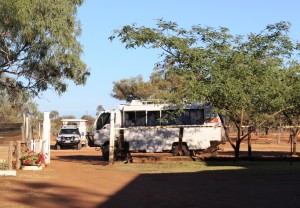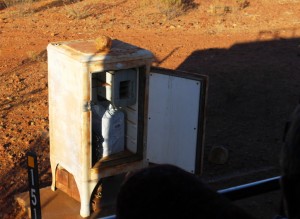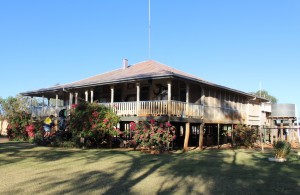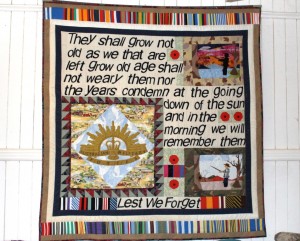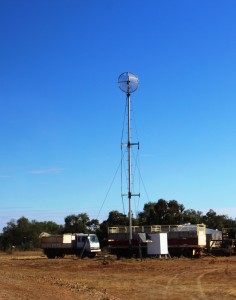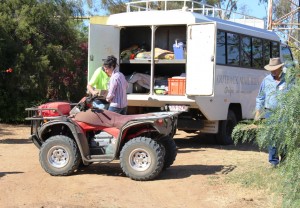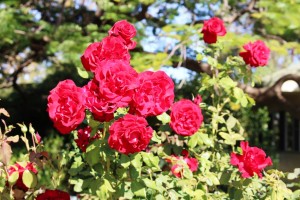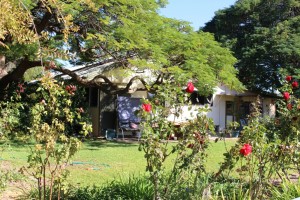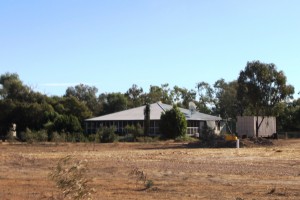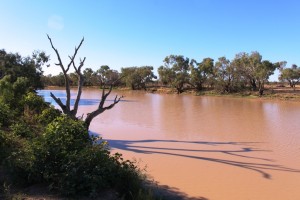During our trip around Australia in 2009 we spent a couple of nights at the caravan park at the resort at Lake Argyle, the mega sized lake on the Ord River in Western Australia’s Kimberly Region. One of the attractions was the relocated house from the Durack property, now flooded by the dam, which has been rebuilt below the wall of the dam, as a museum and memorial to the pioneers of the Northern Australian cattle industry.
We had seen the mail run tour advertised when we were in Quilpie previously, so decided to extend our stay in the town to provide time to include it in our itinerary. The tour departs on Tuesdays and Thursdays on a 430 km mail delivery route making deliveries to 10 stations to the north of Quilpie. The delivery vehicle is a 4WD 12 seater bus with a freight compartment at the rear and a trailer in tow if needed.
We were picked up at the caravan park at 6.45 am, collected the mail that had just arrived from the east and headed for the Adavale “black” road: black because it crosses the black soil pains of the Bullo River. A little to the east is the “red” road, so named for the soil that it crosses. The Red Road is less affected by rain, but today that was not a problem.
The first couple of stations were simply mail box drops, a drum and an ancient refrigerator, but the third was our morning tea stop. Alaric Station has become a sort of retreat for war veterans. The homestead was to be demolished but a request was made for the alternative use. Interested parties made renovations and they were open for business. Hospitality is available to veterans, their families and friends.
There are dormitory rooms at reasonable prices and provision for caravan parking. Veterans come from all over Australia, some staying for considerable periods. The house is decorated with war time memorabilia including many historic pictures. An old windmill is decorated with the names of theaters of war and crowded with the red rooster symbol from Vietnam operations. There is a thriving vegetable garden, watered from the permanent billabong onto which the home-stead faces.
We made a quick toilet stop at Trinidad Station, to be our lunch stop, but then went further north to our most northern delivery to Budgerygar Station. To
get there we passed through Durack Gap, a flat passage between red rock capped mountains, through which Patsy Durack drove his herd of cattle when he moved his operation to the Kimberly region.
Budgerygar Station (correct spelling) is very remote with its northerly border not far south of the Welford National Park near the tiny town of Jundah, where I am writing this post. But we were met by a well dressed lady of the station, probably in her early thirties, with a young family who she is home schooling. She made easy work of tossing the large bags of animal feed that we had delivered, onto a quad bike for storage in a shed.
After examining samples of bolder opal found in the area, brought out by a young daughter of the household, we returned to Trinidad Station for lunch. On the way our driver pointed out two places where extensive excavation had taken place on mountain sides in search of bolder opals.
Trinidad Station was operated by Margaret Pegler and her now late husband. The station is now managed by children, a common situation in the rural scene. Despite the many reports of young people leaving for the cities, a great number of properties are handed on to children. Margaret was away, returning from Brisbane that day, but we were hosted by a daughter who was visiting, from Brisbane, with her husband.
Similar to other homesteads that we saw, Trinidad is enveloped by shady trees. Margaret is a keen gardener. We were greeted by vivid reds and yellows of perfect roses at the front gate. At the rear an extensive orchard provided evidence of the productivity of this land, when you add a little water.
And water was the common theme of much of the conversation. The drought is really hurting and the desire for relief is palpable. As we sat in our van the next day, listening to the rain on the roof, we could not help but be glad for these brave people, despite the damage that we knew the rain was doing to the dirt road to Birdsville that we had planned to travel over the next couple of days.
After our lunch stop we were on our way home. There were a couple of deliveries to make but we were now on the main council road that these stations use to get to Quilpie. But there were two remaining agenda items, a visit to Thylungra Station and afternoon tea beside Thylungra waterhole.
At its peak about 80 people lived on Thylungra. Now the permanent residents are much fewer but the place has a certain stateliness about it. The remaining houses, including
the homestead, are spaced along the creek. We had access to the shearing shed, which is huge, but no longer used, as this station, like so many others, now concentrates on cattle production. But the scope of past operations is obvious.
Afternoon tea was served by Dave, the mailman, in the picnic shelter of the Main Roads provided rest area by Thylungra billabong. A range of beverages were on offer plus care and biscuits. It was a fitting last activity for a very pleasant and interesting day. The final leg of the journey was on the highway that links Quilpie with Windorah, so the distance sped by bringing us back to Quilpie at just after 4.30 pm. As we walked back to our van the grey clouds of tomorrow’s rain were drifting in from the west.
Here is a link to a video of this story.

